warning light MAZDA MODEL MX-30 EV 2022 User Guide
[x] Cancel search | Manufacturer: MAZDA, Model Year: 2022, Model line: MODEL MX-30 EV, Model: MAZDA MODEL MX-30 EV 2022Pages: 547, PDF Size: 79.35 MB
Page 77 of 547
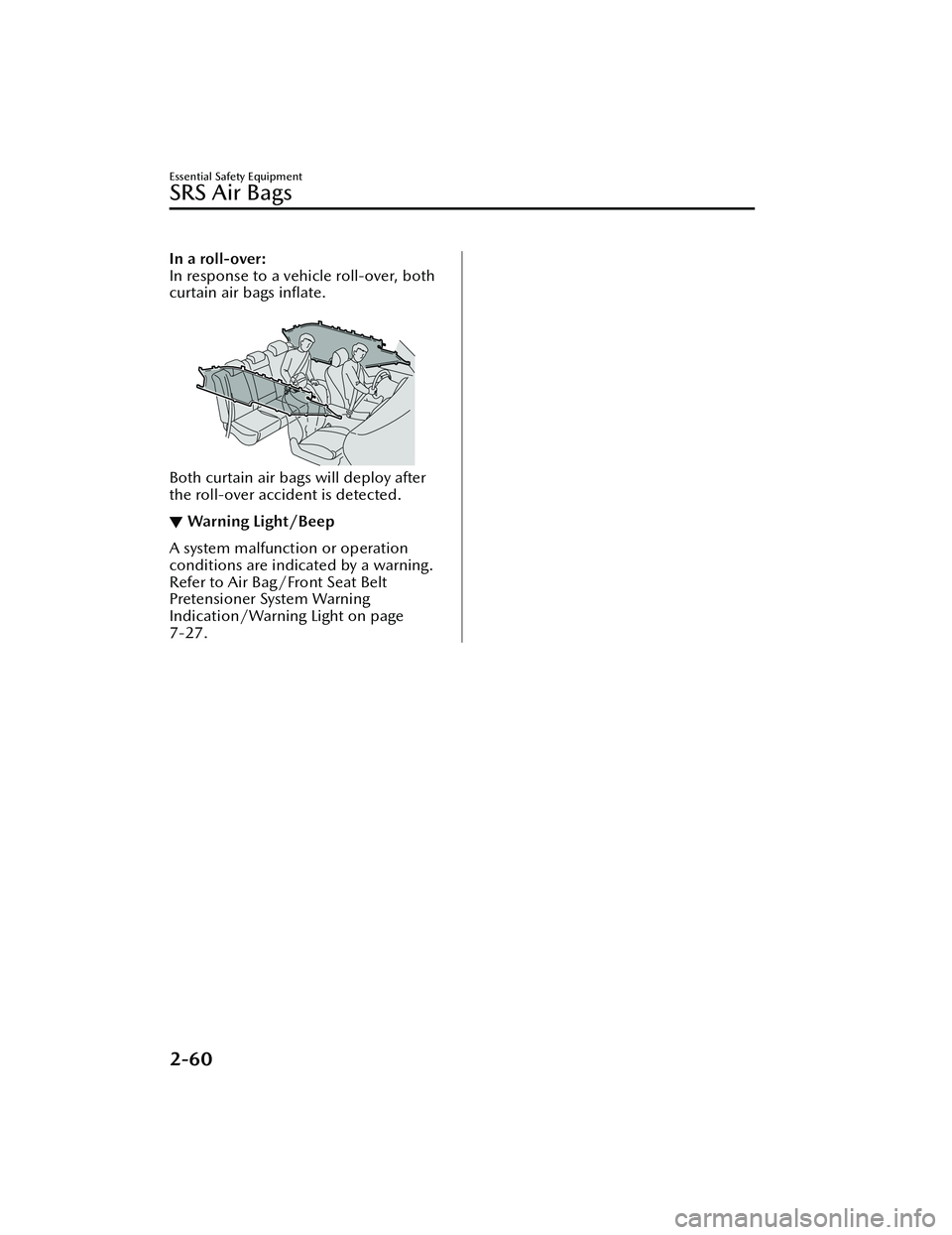
In a roll-over:
In response to a vehicle roll-over, both
curtain air bags inflate.
Both curtain air bags will deploy after
the roll-over accident is detected.
▼ Warning Light/Beep
A system malfunction or operation
conditions are indicated by a warning.
Refer to Air Bag/Front Seat Belt
Pretensioner System Warning
Indication/Warning Light on page
7-27.
Essential Safety Equipment
SRS Air Bags
2-60
MX
-30_8JD4-EA -21G_Edition2_new 2021-5-18 14:38:07
Page 81 of 547

not be detected as severe enough to
deploy the SRS air bag equipment.
Side impacts involving trees or poles
Side impacts with two-wheeled
vehicles
Limitations to roll-over detection:
The following illustration is an example
of an accident that may not be
detected as a roll-over accident.
Therefore, the front seat belt
pretensioners and curtain air bags may
not deploy.
Pitch end over end
Driver and Front
Pa s s e n g e r O cc u p a n t
Classi fication System
▼Driver and Front Passenger
Occupant
Classification System
First, please read "Supplemental
Restraint System (SRS) Precautions"
(page 2-52) carefully.
▼Driver Seat Slide Position Sensor
Your vehicle is equipped with a driver
seat slide position sensor as a part of
the supplemental restraint system. The
sensor is located under the driver seat.
The sensor determines whether the
driver seat is fore or aft of a reference
position and sends the seat position to
the diagnostic module (SAS unit).
The SAS unit is designed to control the
deployment of the driver air bag
depending on how close the driver
seat is to the steering wheel.
The air bag/front seat belt
pretensioner system warning light
fl
ashes if the sensor has a possible
malfunction (page 2-60).
▼ Front Passenger Seat Weight
Sensors
Your vehicle is equipped with a front
passenger seat weight
sensors as a part
of the supplemental restraint system.
These sensors are located under both
of the front passenger seat rails. These
sensors determine the total seated
weight on the front passenger seat and
monitor the seat belt buckle for the
front passenger seat. The SAS unit is
designed to prevent the front
passenger front and side air bags and
knee air bags, and seat belt
pretensioner system from deploying if
Essential Safety Equipment
SRS Air Bags
2-64
MX -30_8JD4-EA -21G_Edition2_new 2021-5-18 14:38:07
Page 82 of 547
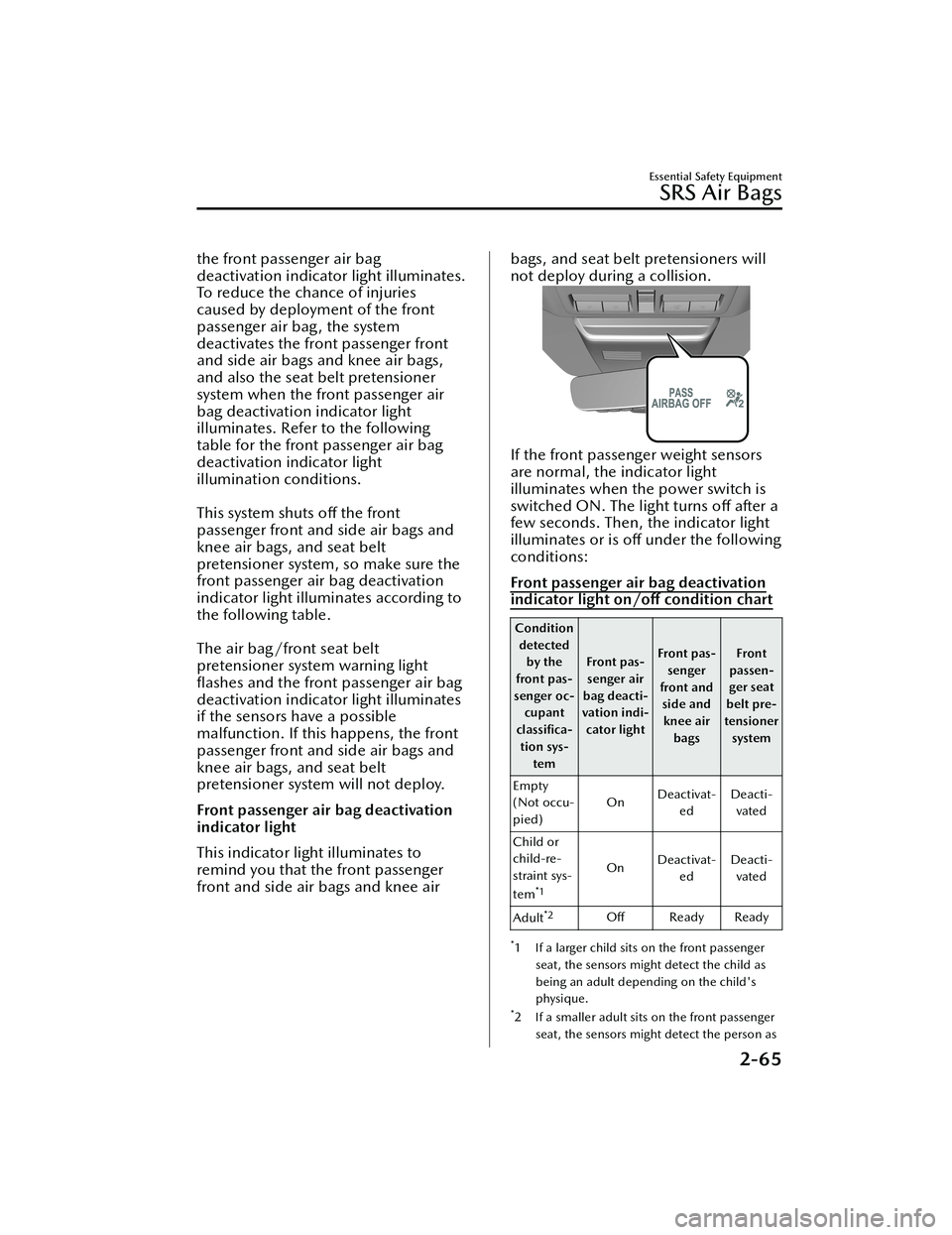
the front passenger air bag
deactivation indicator light illuminates.
To reduce the chance of injuries
caused by deployment of the front
passenger air bag, the system
deactivates the front passenger front
and side air bags and knee air bags,
and also the seat belt pretensioner
system when the front passenger air
bag deactivation indicator light
illuminates. Refer to the following
table for the front passenger air bag
deactivation indicator light
illumination conditions.
This system shuts off the front
passenger front and side air bags and
knee air bags, and seat belt
pretensioner system, so make sure the
front passenger air bag deactivation
indicator light illuminates according to
the following table.
The air bag/front seat belt
pretensioner system warning light
fl ashes and the front passenger air bag
deactivation indicator light illuminates
if the sensors have a possible
malfunction. If this happens, the front
passenger front and side air bags and
knee air bags, and seat belt
pretensioner system will not deploy.
Front passenger air bag deactivation
indicator light
This indicator light illuminates to
remind you that the front passenger
front and side air bags and knee airbags, and seat belt pretensioners will
not deploy during a collision.
If the front passenger weight sensors
are normal, the indicator light
illuminates when the power switch is
switched ON. The light turns off after a
few seconds. Then, the indicator light
illuminates or is o ff under the following
conditions:
Front passenger air bag deactivation
indicator light on/off condition chart
Condition
detected by the
front pas-
senger oc- cupant
classifi ca-
tion sys- tem Front pas-
senger air
bag deacti-
vation indi- cator light Front pas-
senger
front and side andknee air bags Front
passen-
ger seat
belt pre-
tensioner system
Empty
(Not occu-
pied) On
Deactivat-
ed Deacti-
vated
Child or
child-re-
straint sys-
tem
*1
On Deactivat-
ed Deacti-
vated
Adult
*2Off Ready Ready
*1 If a larger child sits on the front passenger
seat, the sensors might detect the child as
being an adult depending on the child's
physique.
*2 If a smaller adult sits on the front passenger
seat, the sensors might detect the person as
Essential Safety Equipment
SRS Air Bags
2-65
MX-30_8JD4-EA -21G_Edition2_new 2021-5-18 14:38:07
Page 83 of 547

being a child depending on the person's
physique.
The curtain air bag is ready for in flating
regardless of what the front passenger air bag
deactivation indicator light on/o ff condition
chart indicates.
If the front passenger air bag
deactivation indicator light does not
illuminate when the power switch is
switched ON and does not illuminate
as indicated in the front passenger air
bag deactivation indicator light on/o ff
condition chart, do not allow a child to
sit in the front passenger seat and
consult an Authorized Mazda Dealer
as soon as possible. The system may
not work properly in an accident.
WARNING
Do not decrease the total seated
weight on the front passenger seat:
When an adult or large child sits on the
front passenger seat, decreasing the
total seated weight on the front
passenger seat required for air bag
deployment is dangerous. The front
passenger seat weight sensors will
detect the reduced total seated weight
condition and the front passenger front
and side air bags and knee air bags,
and the seat belt pretensioner system
will not deploy during an accident. The
front passenger will not have the
supplementary protection of the air
bag , which could result in serious
injury. Decreasing the total seated
weight on the front passenger seat
could result in an air bag not deploying
under the following conditions, for
example:
A front passenger is seated as shown
in the following figure:
A rear passenger pushes up on the
front passenger seat with their feet.
Essential Safety Equipment
SRS Air Bags
2-66
MX -30_8JD4-EA -21G_Edition2_new 2021-5-18 14:38:07
Page 85 of 547

If you place your child on the front
passenger seat, secure the
child-restraint system properly and
slide the front passenger seat as far
back as possible (page 2-44).
NOTE
The system requires about 10
seconds to alternate between turning
the front passenger front and side air
bags and knee air bags, and seat belt
pretensioner system on or o ff.
The front passenger air bag
deactivation indicator light may
illuminate repeatedly if luggage or
other items are put on the front
passenger seat, or if the temperature
of the vehicle's interior changes
suddenly.
The front passenger air bag
deactivation indicator light may
illuminate for 10 seconds if the total
seated weight on the front passenger
seat changes.
The air bag/front seat belt
pretensioner system warning light
might illuminate if the front
passenger seat receives a severe
impact.
If the front passenger air bag
deactivation indicator light does not
illuminate after installing a
child-restraint system on the front
passenger seat,
first, re-install your
child-restraint system according to
the procedure in this owner's
manual. Then, if the front passenger
air bag deactivation indicator light
still does not illuminate, install the
child-restraint system on the rear seat
and consult an Authorized Mazda
Dealer as soon as possible.
If the front passenger air bag
deactivation indicator light
illuminates when an adult is seated
in the front passenger seat, have the
passenger re-adjust their posture by
sitting with their feet on the floor,
and then re-fastening the seat belt. If
the front passenger air bag
deactivation indicator light still
illuminates, move the passenger to
the rear seat. If sitting in the rear seat
is not possible, slide the front
passenger seat as far back as
possible. Consult an Authorized
Mazda Dealer as soon as possible.
▼ Driver and Front Passenger Buckle
Switches
The buckle switches on the front seat
belts detect whether or not the front
seat belts are securely fastened and
further control the deployment of the
air bags.
Essential Safety Equipment
SRS Air Bags
2-68
MX
-30_8JD4-EA -21G_Edition2_new 2021-5-18 14:38:07
Page 86 of 547

Constant Monitoring
▼Constant Monitoring
The following components of the air
bag systems are monitored by a
diagnostic system:
Front air bag sensorsCrash sensors, and diagnostic
module (SAS unit)
Side crash sensorsAir bag modulesFront seat belt pretensionersAir bag/Front seat belt pretensioner
system warning light
Related wiring
Driver seat slide position sensorFront passenger occupant
classi
fication sensor
Front passenger occupant
classification module
Front passenger air bag deactivation
indicator light
Front passenger seat belt buckle
switch
The diagnostic module continuously
monitors the system's readiness. This
begins when the power switch is
switched ON and continues while the
vehicle is being driven.
Essential Safety Equipment
SRS Air Bags
2-69
MX -30_8JD4-EA -21G_Edition2_new 2021-5-18 14:38:07
Page 92 of 547
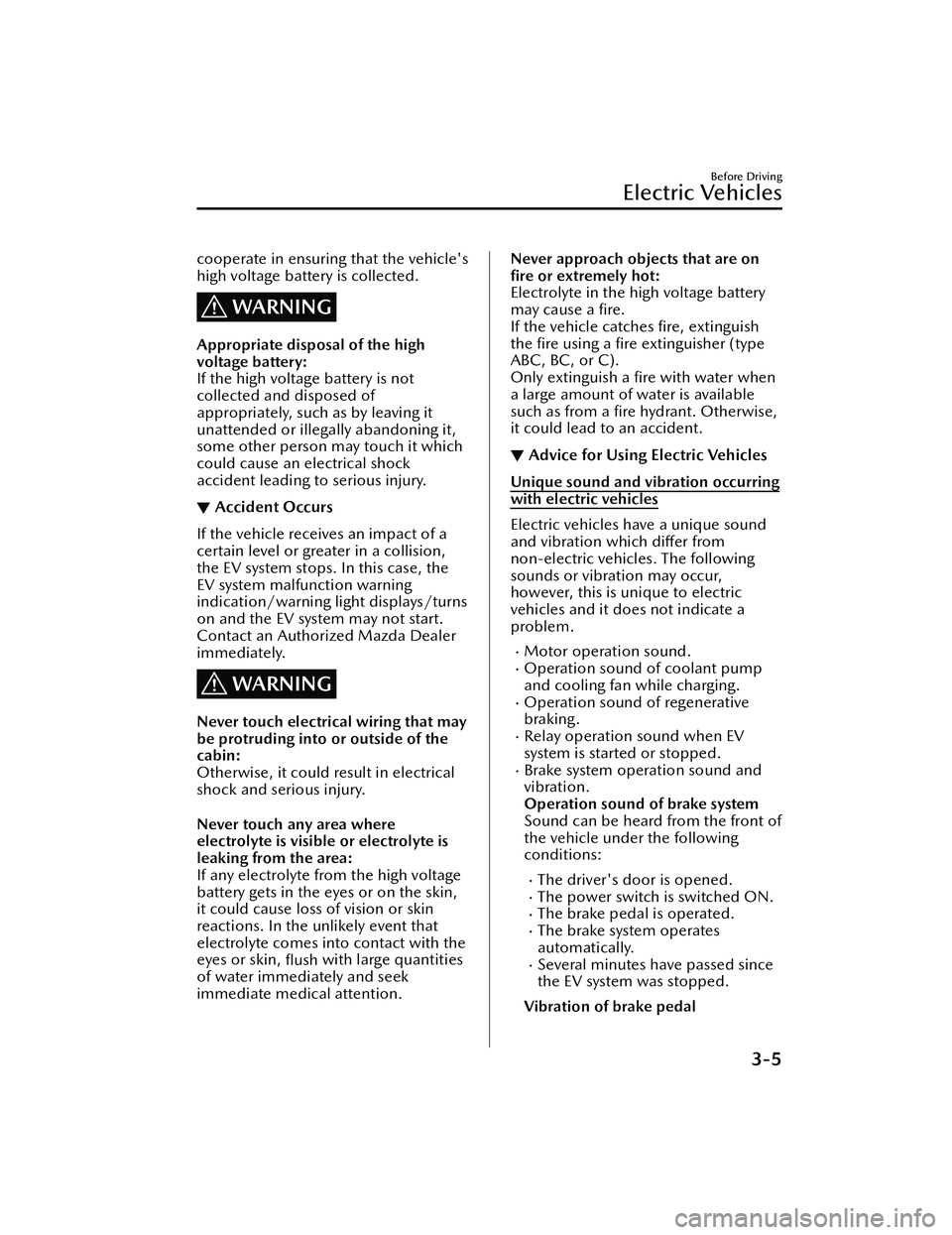
cooperate in ensuring that the vehicle's
high voltage battery is collected.
WARNING
Appropriate disposal of the high
voltage battery:
If the high voltage battery is not
collected and disposed of
appropriately, such as by leaving it
unattended or illegally abandoning it,
some other person may touch it which
could cause an electrical shock
accident leading to serious injury.
▼Accident Occurs
If the vehicle receives an impact of a
certain level or greater in a collision,
the EV system stops. In this case, the
EV system malfunction warning
indication/warning light displays/turns
on and the EV system may not start.
Contact an Authorized Mazda Dealer
immediately.
WARNING
Never touch electrical wiring that may
be protruding into or outside of the
cabin:
Otherwise, it could result in electrical
shock and serious injury.
Never touch any area where
electrolyte is visible or electrolyte is
leaking from the area:
If any electrolyte from the high voltage
battery gets in the eyes or on the skin,
it could cause loss
of vision or skin
reactions. In the unlikely event that
electrolyte comes into contact with the
eyes or skin, flush with large quantities
of water immediately and seek
immediate medical attention.
Never approach objects that are on
fi re or extremely hot:
Electrolyte in the high voltage battery
may cause a fire.
If the vehicle catches fire, extinguish
the fire using a fire extinguisher (type
ABC, BC, or C).
Only extinguish a fire with water when
a large amount of water is available
such as from a fire hydrant. Otherwise,
it could lead to an accident.
▼ Advice for Using Electric Vehicles
Unique sound and vibration occurring
with electric vehicles
Electric vehicles have a unique sound
and vibration which di
ffer from
non-electric vehicles. The following
sounds or vibration may occur,
however, this is unique to electric
vehicles and it does not indicate a
problem.
Motor operation sound.Operation sound of coolant pump
and cooling fan while charging.
Operation sound of regenerative
braking.
Relay operation sound when EV
system is started or stopped.
Brake system operation sound and
vibration.
Operation sound of brake system
Sound can be heard from the front of
the vehicle under the following
conditions:
The driver's door is opened.The power switch is switched ON.The brake pedal is operated.The brake system operates
automatically.
Several minutes have passed since
the EV system was stopped.
Vibration of brake pedal
Before Driving
Electric Vehicles
3-5
MX -30_8JD4-EA -21G_Edition2_new 2021-5-18 14:38:07
Page 96 of 547
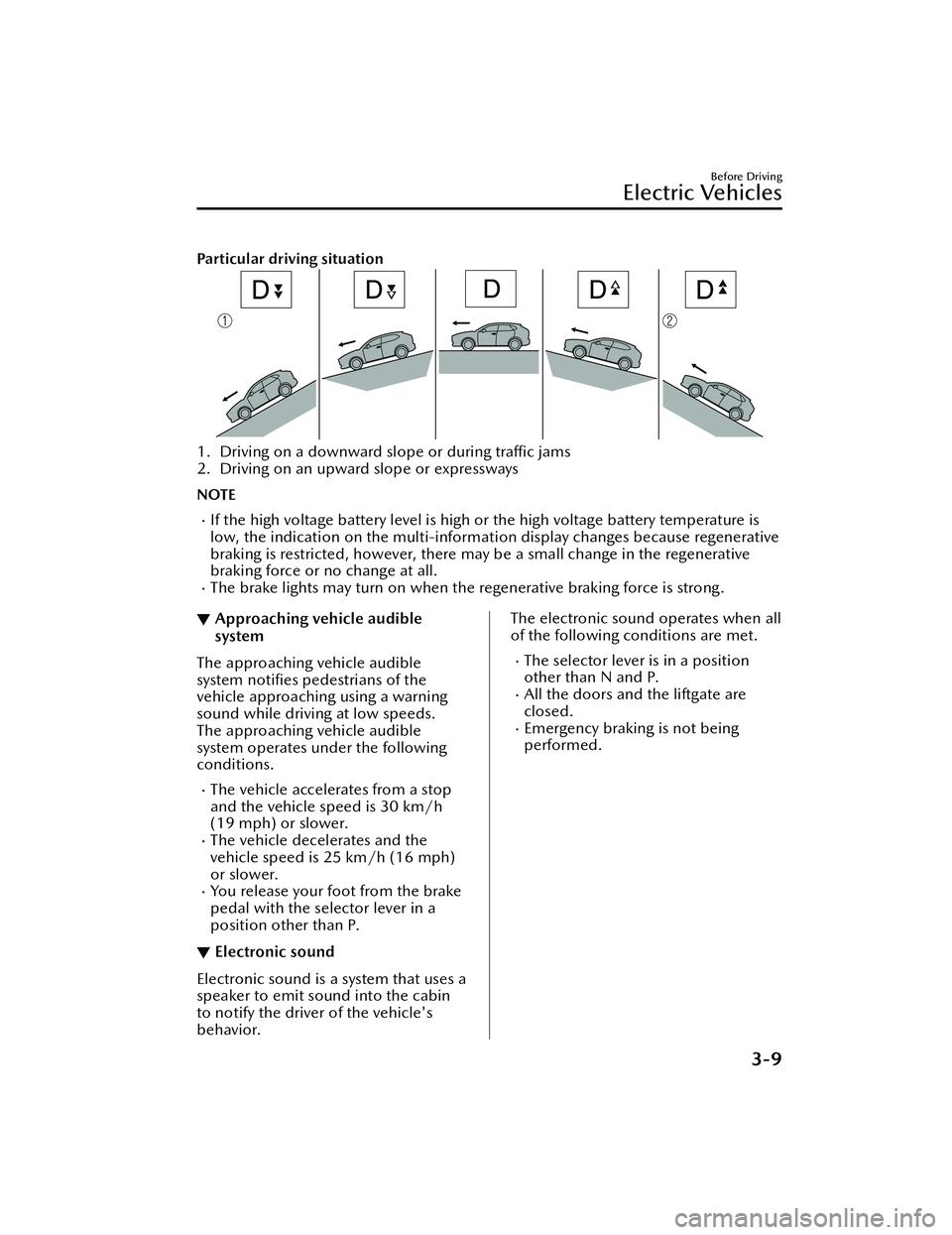
Particular driving situation
1. Driving on a downward slope or during traffic jams
2. Driving on an upward slope or expressways
NOTE
If the high voltage battery level is high or the high voltage battery temperature is
low, the indication on the multi-informat ion display changes because regenerative
braking is restricted, however, there may be a small change in the regenerative
braking force or no change at all.
The brake lights may turn on when the regenerative braking force is strong.
▼ Approaching vehicle audible
system
The approaching vehicle audible
system noti
fies pedestrians of the
vehicle approaching using a warning
sound while driving at low speeds.
The approaching vehicle audible
system operates under the following
conditions.
The vehicle accelerates from a stop
and the vehicle speed is 30 km/h
(19 mph) or slower.
The vehicle decelerates and the
vehicle speed is 25 km/h (16 mph)
or slower.
You release your foot from the brake
pedal with the selector lever in a
position other than P.
▼ Electronic sound
Electronic sound is a system that uses a
speaker to emit sound into the cabin
to notify the driver of the vehicle's
behavior.
The electronic sound operates when all
of the following conditions are met.
The selector lever is in a position
other than N and P.
All the doors and the liftgate are
closed.
Emergency braking is not being
performed.
Before Driving
Electric Vehicles
3-9
MX
-30_8JD4-EA -21G_Edition2_new 2021-5-18 14:38:07
Page 97 of 547
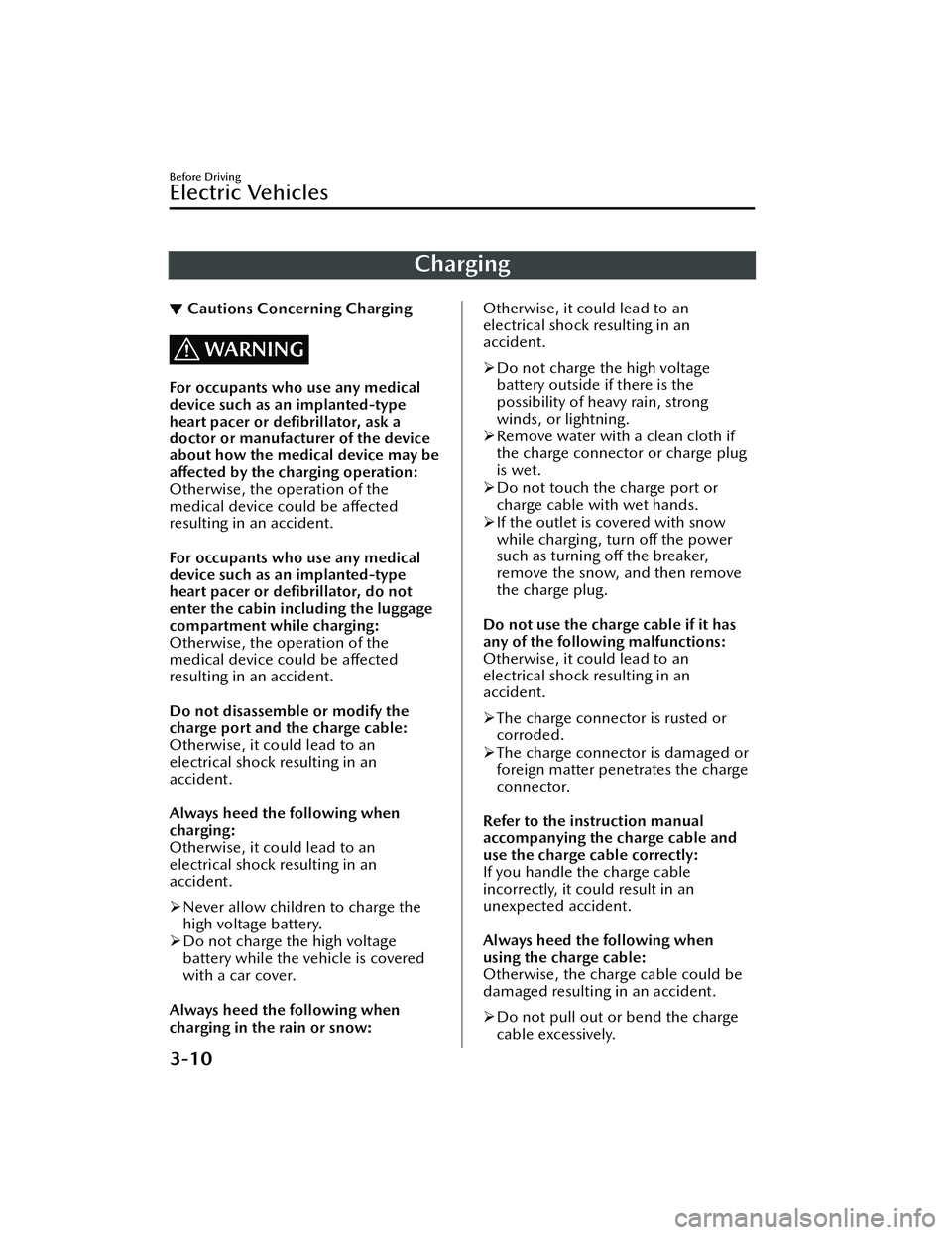
Charging
▼Cautions Concerning Charging
WARNING
For occupants who use any medical
device such as an implanted-type
heart pacer or
defibrillator, ask a
doctor or manufacturer of the device
about how the medical device may be
a ff ected by the charging operation:
Otherwise, the operation of the
medical device could be a ffected
resulting in an accident.
For occupants who use any medical
device such as an implanted-type
heart pacer or de fibrillator, do not
enter the cabin including the luggage
compartment while charging:
Otherwise, the operation of the
medical device could be a ffected
resulting in an accident.
Do not disassemble or modify the
charge port and the charge cable:
Otherwise, it could lead to an
electrical shock resulting in an
accident.
Always heed the following when
charging:
Otherwise, it could lead to an
electrical shock resulting in an
accident.
Never allow children to charge the
high voltage battery.
Do not charge the high voltage
battery while the vehicle is covered
with a car cover.
Always heed the following when
charging in the rain or snow:
Otherwise, it could lead to an
electrical shock resulting in an
accident.
Do not charge the high voltage
battery outside if there is the
possibility of heavy rain, strong
winds, or lightning.
Remove water with a clean cloth if
the charge connector or charge plug
is wet.
Do not touch the charge port or
charge cable with wet hands.
If the outlet is covered with snow
while charging, turn o ff the power
such as turning o ff the breaker,
remove the snow, and then remove
the charge plug.
Do not use the charge cable if it has
any of the following malfunctions:
Otherwise, it could lead to an
electrical shock resulting in an
accident.
The charge connector is rusted or
corroded.
The charge connector is damaged or
foreign matter penetrates the charge
connector.
Refer to the instruction manual
accompanying the charge cable and
use the charge cable correctly:
If you handle the charge cable
incorrectly, it could result in an
unexpected accident.
Always heed the following when
using the charge cable:
Otherwise, the charge cable could be
damaged resulting in an accident.
Do not pull out or bend the charge
cable excessively.
Before Driving
Electric Vehicles
3-10
MX -30_8JD4-EA -21G_Edition2_new 2021-5-18 14:38:07
Page 102 of 547
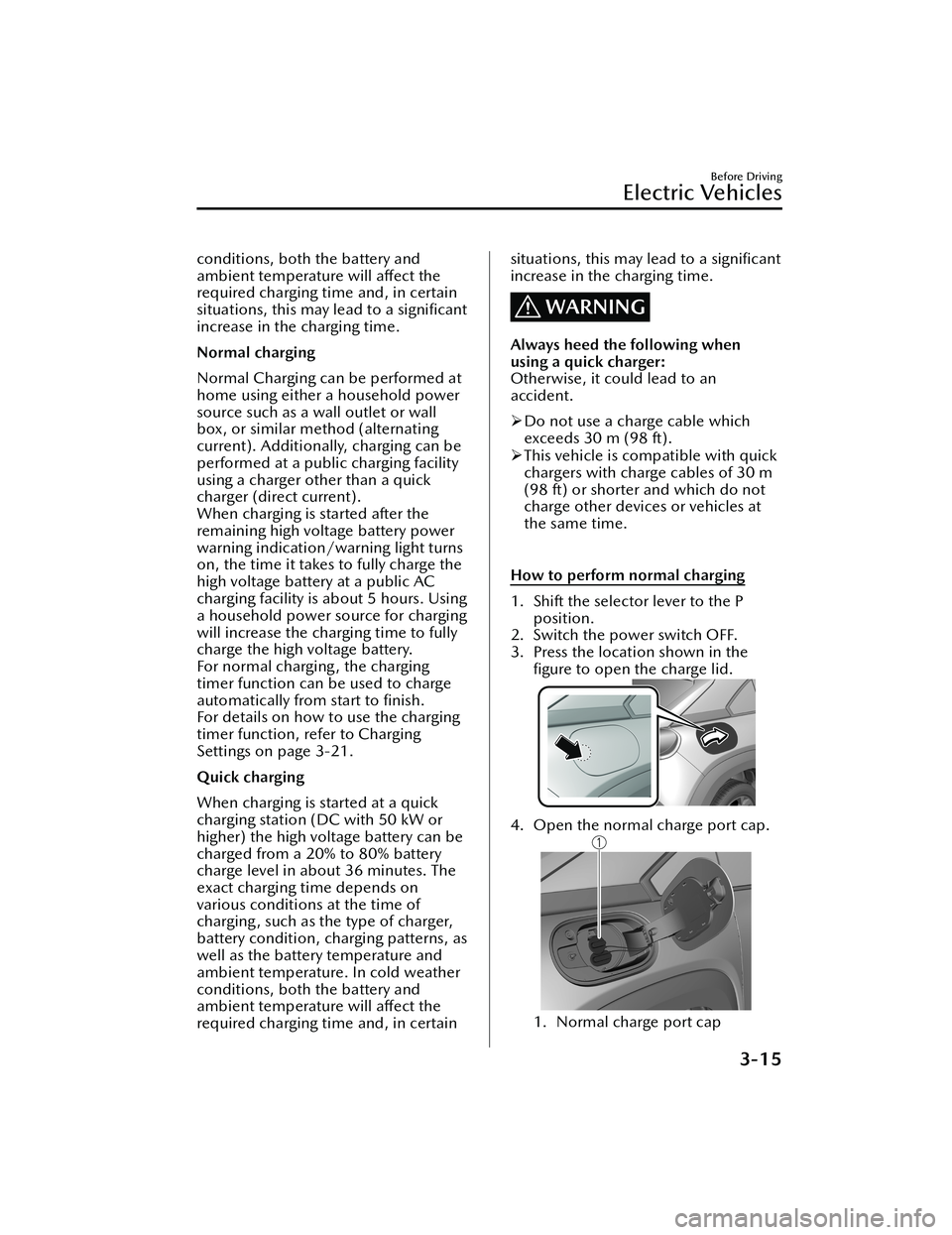
conditions, both the battery and
ambient temperature will affect the
required charging time and, in certain
situations, this may lead to a signi ficant
increase in the charging time.
Normal charging
Normal Charging can be performed at
home using either a household power
source such as a wall outlet or wall
box, or similar method (alternating
current). Additionally, charging can be
performed at a public charging facility
using a charger other than a quick
charger (direct current).
When charging is started after the
remaining high voltage battery power
warning indication/warning light turns
on, the time it takes to fully charge the
high voltage battery at a public AC
charging facility is about 5 hours. Using
a household power source for charging
will increase the charging time to fully
charge the high voltage battery.
For normal charging , the charging
timer function can be used to charge
automatically from start to finish.
For details on how to use the charging
timer function, refer to Charging
Settings on page 3-21.
Quick charging
When charging is started at a quick
charging station (DC with 50 kW or
higher) the high voltage battery can be
charged from a 20% to 80% battery
charge level in about 36 minutes. The
exact charging time depends on
various conditions at the time of
charging , such as the type of charger,
battery condition, ch arging patterns, as
well as the battery temperature and
ambient temperature. In cold weather
conditions, both the battery and
ambient temperature will aff ect the
required charging time and, in certainsituations, this may lead to a significant
increase in the charging time.
WARNING
Always heed the following when
using a quick charger:
Otherwise, it could lead to an
accident.
Do not use a charge cable which
exceeds 30 m (98 ft).
This vehicle is compatible with quick
chargers with charge cables of 30 m
(98 ft) or shorter and which do not
charge other devices or vehicles at
the same time.
How to perform normal charging
1. Shift the selector lever to the P position.
2. Switch the power switch OFF.
3. Press the location shown in the figure to open the charge lid.
4. Open the normal charge port cap.
1. Normal charge port cap
Before Driving
Electric Vehicles
3-15
MX -30_8JD4-EA -21G_Edition2_new 2021-5-18 14:38:07